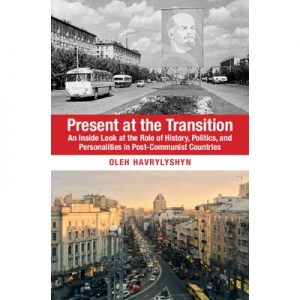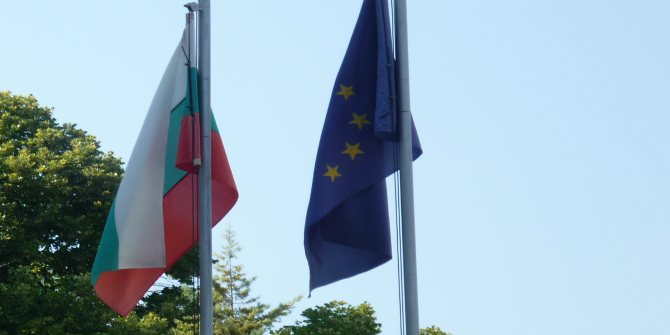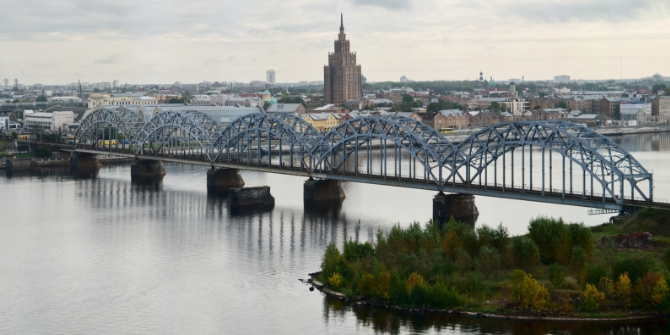Renowned scholar of post-communist transition, Professor Oleh Havrylyshyn, passed away on 20 September 2020. In this piece, Dr Elodie Douarin pays tribute to his work as a scholar and colleague, reflects on the contributions of his last book, Present at the Transition, and shares her experience of working with him on their recent co-edited collection, Palgrave Handbook of Comparative Economics.
Present at the Transition: Remembering Professor Oleh Havrylyshyn
 Oleh Havrylyshyn died unexpectedly in his sleep on 20 September 2020, at the age of 77. He was then a research professor at the Institute of European, Russian, and Eurasian Studies at Carleton University, and he had previously held positions at diverse universities in Canada and in Europe. He had also served as deputy director general in the European Department of the International Monetary Fund (IMF) and as deputy Finance Minister and deputy Foreign Minister in post-independence Ukraine. He had studied at Queen’s University in Canada, and earned his PhD at the prestigious Massachusetts Institute of Technology (MIT).
Oleh Havrylyshyn died unexpectedly in his sleep on 20 September 2020, at the age of 77. He was then a research professor at the Institute of European, Russian, and Eurasian Studies at Carleton University, and he had previously held positions at diverse universities in Canada and in Europe. He had also served as deputy director general in the European Department of the International Monetary Fund (IMF) and as deputy Finance Minister and deputy Foreign Minister in post-independence Ukraine. He had studied at Queen’s University in Canada, and earned his PhD at the prestigious Massachusetts Institute of Technology (MIT).
Oleh was an outstanding scholar and a skilled teacher, who was passionate about his subject. Although he is mostly known for his work on the process of post-communist transition in Eastern Europe and Central Asia, Oleh had much broader interests and had also worked on, among other things, female labour supply and the valuation of care and home-making work, and on the role of history and institutional quality on growth in mediaeval Dubrovnik.
I feel really lucky to have worked with Oleh over the past three years, as we co-edited the Palgrave Handbook of Comparative Economics, which was released only a few weeks ago. When he died peacefully at his home in Ottawa, we had only finished working through the first full set of proofs three days earlier. I had recently sent him my congratulations and comments on his book with Cambridge University Press, Present at the Transition: An Inside Look at the Role of History, Politics and Personalities in Post-Communist Countries, which had been out since May 2020 and I had read over the summer while updating my teaching material for the fall.
As an academic, it is a privilege to have worked with him: he was a kind and tireless co-editor, providing truly constructive feedback, at speed, and always contributing to the debate with benevolence. He was a great role model for his incredible reliability and stamina, and because he treated everybody with great respect. As a teacher, I have repeatedly used his articles and books in my classes for their clarity and insight. In 2017, he gave a guest lecture in my undergraduate class on the economics of transition, which was an absolute tour de force: presenting a grand tour of the experience of transition in an hour, without compromising on the complexity of the ideas presented. My students loved it, and I thus had high expectations about his new book. I have not been disappointed.
Present at the Transition is a book that only Oleh could have written: it builds on his extensive and varied experience as an academic, a policymaker and adviser. Indeed, Oleh proposes here a compelling narrative, based on both his extensive knowledge of the literature and his personal experience of the process. This allows him to present a comprehensive overview of transition, explaining the process from authoritarian political regime with a centrally planned economy to more democratic (most of the time) and more market-oriented economies in the post-communist world, with nuance and precision, while peppering the text with anecdotes to liven up and shed additional light on the points being made.

Image Credit: Photo by Ryan Lum on Unsplash
The book is organised into four parts and each contributes to adding a layer of complexity and thus progressively deepening the analysis. Contrary to many books that have been written in the past on transition, Oleh does not segment the reforms to investigate them in turns (political then economic, liberalisation or stabilisation then privatisation). Instead, he builds a story to relate the interplay and complementarity between reforms more effectively, while also recognising that all elements of reforms are not the same, in particular that privatisation is not liberalisation, and vice versa.
Part One, ‘The Diverse Paths Taken in Transition’, sets the scene by establishing key stylised facts 30 years after the fall of the Berlin Wall. Oleh acknowledges important early academic debates (in particular around the speed and sequencing of reforms) and settles them, as much as possible, using both a presentation of important trends in relevant indicators of progress (for example, GDP growth, Human Development Index, democracy, rule of law, corruption, the transition indicators from the European Bank for Reconstruction and Development to measure progress in economic liberalisation), and by building on an extensive review of the empirical literature. This section thus develops a knowledge base for those less familiar with the topic, but also clarifies from the outset some of the most common misunderstandings or misconceptions around transition. The latter allows readers more familiar with the literature to understand the perspective and definitions adopted by Oleh, and thus to get on board with the rest of the argument.
Part Two, ‘Choice of Strategy: Was it History? Politics? Or People?’, can then dig deeper into the process of reforms, exploring the drivers that can explain the strategies followed and the constraints that could delay or derail reforms. Because the background trends have been set already, this section can be fully focused on progress in reforms, recognising the complexity of the process and the varied outcomes. It is also a section where Oleh’s rich experience comes through, as he relates the reality of policy design in practice and livens up the broad trends and outcomes with smaller stories of people caught in the process of advising and advocating for reforms. And all anecdotes are true to Oleh’s warm and caring personality, as well as his professionalism: do not expect gossip, but instead informative and respectful stories, likely to bring up fond memories for those who knew him.
Part Three, ‘Domestic Vested Interests and Reforms’, then takes the analysis a step further, this time exploring the issue of institutional change and presenting some of the vicious circles, and windows of opportunity, derived from the distribution of political and economic power in the early years of transition. This section is reminiscent of the argument presented in his 2007 book, Divergent Paths in Post-Communist Transformation: Capitalism for All or Capitalism for the Few?, but bringing in more recent evidence and analyses from the literature and presenting historical data only recently compiled (notably on the distribution of income and wealth through time in the region, and on the evolution of corruption starting from communist times).
This section also gives a greater place to the lived experience of transition for the population that went through it. Oleh relates the expectations and hopes that came with the fall of the Berlin Wall, relying on household survey data capturing the attitudes and values of the masses, and proposes to interpret the apparent disillusionment of some in the face of positive macroeconomic changes. In doing so, Oleh manages to convincingly tie in some of the loose ends in the current empirical literature while highlighting some areas for future research. Finally, Part Four concludes revisiting the process in its entirety. Oleh goes back to his definitions and again busts some of the myths of transition based on the accumulated evidence presented in the book, before questioning what is next for the region.
In my mind, Present at the Transition thus makes a number of contributions, which means that it stands out from earlier attempts to review the process of transition overall. The first one is the layering approach that Oleh adopted here, which allows for a nuanced presentation that recognises the complexity of the process of change that the region experienced. The second one is the inclusive and pedagogical approach taken in the book. Having worked on transition for a number of years now, I am very aware of the points of disagreement that exist in the literature. However, more often than not, disagreements stem from divergent definitions or measurements. Thus, by providing clear definitions and presenting supporting graphical evidence for his interpretations as well as multiple academic sources, Oleh really tries to reconcile views and settle debates: nothing is assumed, everything is exposed. Finally, the book benefits from Oleh’s broad experience and astute understanding of transition, allowing him to add credible narratives where the evidence is patchy or missing.
The feedback from my students this year has thus been very clear, as some of them got in touch to report how much the book had helped them to click in the last jigsaw pieces and make more sense of transition overall, the conflicting narratives sometimes found in the literature and the apparent disconnect between popular dissatisfaction with transition in the region and the macroeconomic evidence.
Present at the Transition wasn’t meant to be Oleh’s last book. He was full of projects, wanting to return to his work on gender roles, curious to explore the possible impact of COVID-19 in the region and hopeful and anxious to see what the protest in Belarus would lead to. But it is a fitting legacy to his work on transition and a great testimony of his experience and contribution to the field.
Note: This feature essay gives the views of the author, and not the position of the LSE Review of Books blog, or of the London School of Economics.







